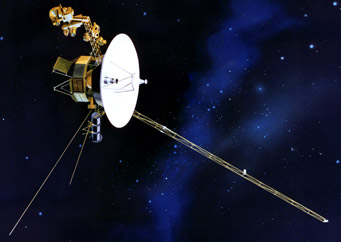Thirty-four years after their 1977 launches, we’re still hearing about discoveries made by NASA’s Voyager spacecraft. To the tally that includes Jupiter’s faint ring, active volcanoes on Io, and Neptune’s Great Dark Spot — not to mention the ongoing mission to find the outer limit of the Sun’s magnetic influence — add another first: the detection of a particular kind of hydrogen signal called Lyman-alpha emission from the Milky Way itself.
Lyman-alpha is a specific ultraviolet wavelength (121.6 nm, to be exact) emitted when a hydrogen atom’s electron drops down one orbital energy level to the ground state. It’s emitted by hydrogen atoms after they recover from being ionized by hot stars’ ultraviolet radiation or after encountering shock waves from supernovae or stellar winds. Because of these associations, Lyman-alpha is thought to be a good tracer of galaxies’ star-formation rates.

Billions of miles from home, the Voyager spacecraft (one illustrated here) are still collecting data. A new study of archival observations has revealed a faint signal from the Milky Way that has long eluded instruments closer to Earth.
NASA / JPL-Caltech
Tracking these photons is tough, though, because they tend to be scattered and absorbed many times by the neutral hydrogen surrounding the ionizing source regions and pervading interstellar space. Astronomers have some good ideas about how the radiation moves about, and how that radiation is related to emission at another, more easily traceable red-light wavelength called hydrogen-alpha. Still, it’d be nice to test these ideas in places where researchers have good estimates of gas density and geometry, as they do for our own galaxy.
Until now, astronomers hadn’t detected Lyman-alpha emission from the Milky Way, because of the interference caused by emission created when solar Lyman-alpha photons are scattered by neutral hydrogen atoms in the solar system. Astronomers have detected plenty of Lyman-alpha emission in far-away galaxies, but that’s because the light from those galaxies is redshifted to wavelengths where solar-system interference isn’t a problem.
The international team of researchers used archival data from the ultraviolet spectrometers on board both Voyager spacecraft, spanning 1993 to mid-2003 for Voyager 1, and 1993 to mid-1998 for Voyager 2, after the craft had reached about 40 astronomical units out. As Rosine Lallement (CNRS) and her colleagues report in December 1st's Science, the signals were faint, but there looks to be concentrated Lyman-alpha along the Milky Way’s plane, in the general (stress “general”) direction of star formation.
The observations may allow astronomers to test theories of how Lyman-alpha propagates and relates to H-alpha emission, which would help observers study star formation, particularly in galaxies with weak angular resolution. But at the moment it’s more tantalizing than anything. “I view the Lallement paper as a pilot test,” says Jeffrey Linsky (JILA). “It answers the question: how far away from the Sun do you have to go before you can do these measurements?” Low power levels for the Voyagers mean one spectrometer’s been turned off and the other can’t point any more, so detailed data have to wait for a more sophisticated spectrometer to get beyond Pluto’s orbit.
Such an instrument is already en route, on board the New Horizons spacecraft. It’s arriving at Pluto in 2015, and afterward the craft’s Alice spectrometer could be used to study the galaxy’s Lyman-alpha emission, says principal investigator Alan Stern. The mission’s scientists are already using Alice to study hydrogen emission inside the solar system, he says.
To see where the Voyager spacecraft are now, watch the real-time odometers on the mission website.
You can also see where New Horizons is.
 3
3
Comments
Trane Francks
December 2, 2011 at 4:31 pm
It's remarkable and inspiring to see that 34-year-old spacecraft can still be generating interesting scientific data. What a credit to the engineers who created the mission. Well done, NASA.
You must be logged in to post a comment.
Bill Vittitow
December 2, 2011 at 5:11 pm
I had heard of Lyman-alpha before but didn't know much about it. This filled in a gap in my knowledge.
Good article
You must be logged in to post a comment.
Mario Z.
December 5, 2011 at 9:35 am
Thirty-four years ago began my passion for astronomy, this event was my personal "Big Bang"
You must be logged in to post a comment.
You must be logged in to post a comment.